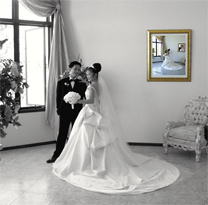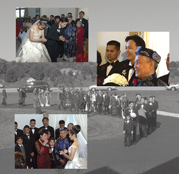articles/Digital/digitaltalkingplunge3-page1
Digital Taking the plunge Part 3 - part 1 of 1 2
by Mike McNamee Published 01/03/2003

IN the preceding weeks you must have discovered how remarkably simple digital imaging appears to be, and of course it is to some extent. There are however a small number of pitfalls that you really need to be aware of and to insure against. As part of this final discussion on taking the plunge, I will take a look at what you need to do to safeguard your business and your reputation from an impending disaster. Keep in mind that disasters also happen to film photographers and above all to sloppy business people, but first let's explore more of the benefits.
To open this last look at going digital, I want to help you explore some of the possibilities that digital opens up in the creation of saleable and profitable products, not just for the wedding and portrait photographer, but just about everyone from those who make this a cottage industry, freelance news and sport photographers, nature photographers and even fine art photographers.
As a wedding photographer my interest of course is in increasing the amount of money I can make for my Saturday, since that is singularly the most saleable day I have. Now that I have eliminated film and paper proofs from the equation, that one time cost has now been converted directly into profit. Moreover the material cost of making wedding albums has gone down considerable, just because I colour manage and adjust image sizes of my own files. I am getting the lowest possible print prices for chromogenic (C type) colour prints from my lab.
The reason I still use a lab for wedding work, rather than output my own ink jet prints in house, is rather simple. One of my major product lines is a hand-bound library style album where the prints bleed off the full page, the bookbinder who fulfils this work won't accent anything other than real photographic prints. However, as I mentioned in closing part two, I also sell GraphiStudio albums from Italy. Graphi books come in two varieties, one printed with ink on board or paper, the other on photographic paper.
Resin coated photographic paper, as any lab technician will tell you, was designed and manufactured to one premise... to lay flat... full stop. It was meant either to be displayed in photo frames or presented in albums, but it wasn't meant to be folded in the middle, or anywhere else for that matter. Since Graphi albums feature panoramic images that span the middle with at least twenty percent of the pages, for this reason alone I only sell the ink on board or paper version just because experience tells me that folded prints, when opened and closed repeatedly will eventually fray across the crease.

I really like Graphi albums and have to point out that they have the potential for being the most profitable products you offer. Once the bride and groom have made the selections for their wedding album, all you do is drag and drop those images into a separate folder, do any manipulative work you want to and save the images either as 12 resolution JPEGs or as I prefer to, as TIFFs.You then burn a CD and send it to Italy with the order form and your input is done, until the album comes back. The add-on sales are great with mini albums, calendars and of course, parents' books, you just can't fail to make money with it.
During the past eighteen years I haven't sold one single self assembly album, I don't carry an inventory of pages, matts, dry mount tissues, double sided adhesive tape or anything associated with assembling wedding albums. Every book I ever sell is made in a factory with the images I supply to the bookbinder. My other two bookbinders are Leather Craftsmen of New York and Zookbinders from here in the Chicago area. Both are top of the line, deliciously expensive, very luxurious and in both cases I send out photographic prints and they trim and permanently mount the pictures onto heavy card pages, whether it is an album with a matted look or a flush-bound picture story book. The books are made with real leather, no Naugas or Aristos sacrificed their lives for these products... only real leather
Having said that there is still a fair amount of work to be done in preparing images for lab printing. I resize, colour balance and make up my own templates for special album pages, but of course there are Photoshop plug-ins that you can purchase that will do some of that work, like Zookbinder's DigimatZ. Here I am in America, there most of you are in the U.K. and It is an awful long time since I had any kind of communication with any of my lab friends back home, so rather than advise you on any form of colour management projects, I am going to suggest that you talk with the customer service personnel in the digital department at your lab. It may well be that they also have similar templates to those offered by Zookbinders or Fuji's Studio Master Pro., the best I can do here is to elaborate a little on the way I do things and let you be the judge of whether you want to get involved in all the post production or you want to pay the lab to handle most of it.
In the case of wedding clients, when the couple place the order for their album(s) I first create a folder with their name on it and place it into the work in progress folder, I do the same for the guest orders and parents' albums plus one folder for the Bride's album. From the CDs I drag the image files into each folder for prints that are ordered. There are simpler and quicker methods and I have tried others, but found this allows me to collate the orders on the return from the lab and or bookbinders, so I am willing to do a little extra work for that convenience.
One folder at I time, I go through the orders in Photoshop, cropping and adjusting colour fidelity and balance, finally I add the unsharp mask (Filters>Sharpening>Unsharp Mask). For 5" x 4" prints I put four up on a 10 x 8 sheet, 7 x 5's are set up as two on a sheet. If it is an order for an album, depending on whether it is to be lab printed or sent to Graphi, I will set up, size and orient the images to correspond with the manufacturers requirements. If I am making a Zookbinder's book, my decision will be made based on the client budget, whether I use DigimatZ or my own templates, remember every other digital photographer can acquire a DigimatZ CD but my templates will remain uniquely mine and therefore only go into my higher priced service levels.
You are currently on page 1 Contact Mike McNamee
1st Published 01/03/2003
last update 09/12/2022 14:53:21
More Digital Articles
There are 0 days to get ready for The Society of Photographers Convention and Trade Show at The Novotel London West, Hammersmith ...
which starts on Wednesday 15th January 2025





